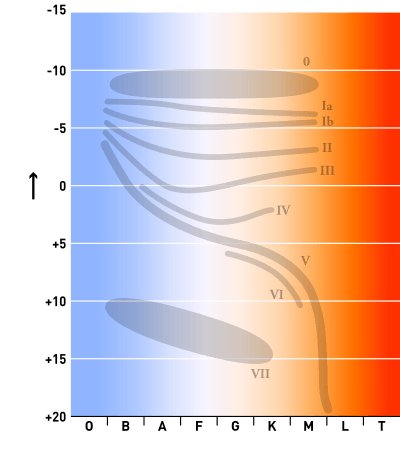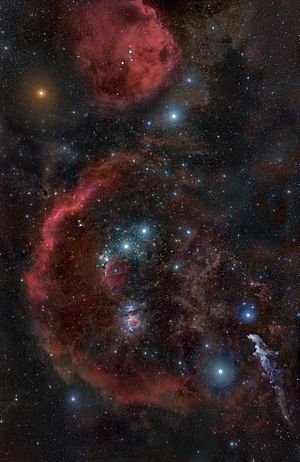Red supergiant star facts for kids
Red supergiants (RSGs) are huge stars that are very bright. They are known as "supergiants" because of their amazing size and brightness. These stars have a special color, usually orange or red, and are classified as K or M type stars.
Even though red supergiants are not the heaviest or brightest stars, they are the largest stars in the universe when it comes to their volume (how much space they take up). Imagine a star so big that our Sun would look like a tiny speck next to it!
Two of the most famous red supergiants you might have heard of are Betelgeuse and Antares. They are so bright that you can often see them easily in the night sky.
Contents
What Makes Red Supergiants Special?
Red supergiants are truly unique stars. They are very cool compared to other stars, but they are incredibly large.
How Big and Hot Are They?
Red supergiants have surface temperatures that are cooler than our Sun, usually below 4,100 K. To give you an idea, our Sun's surface is about 5,778 K!
Even though they are cooler, red supergiants are hundreds to over a thousand times wider than our Sun. If a red supergiant were in the place of our Sun, it might even swallow up planets like Mars or Jupiter!
For example, a star called Alpha Herculis is a giant star that is about 264 to 303 times the size of our Sun. But Epsilon Pegasi, which is a red supergiant, is "only" about 185 times the size of our Sun. This shows that being a supergiant is not just about being the absolute biggest, but also about how bright and powerful the star is.
How Much Do They Weigh?
Red supergiants are very heavy, with masses between about 10 and 40 times the mass of our Sun.
Because they are so big and bright, they lose a lot of their material into space. This is like a giant cosmic sneeze, where the star blows off parts of itself. This process, called "mass loss," creates clouds of gas and dust around the star.
By the end of their lives, red supergiants can lose a lot of their original mass. The heaviest ones lose mass much faster. It seems that most red supergiants end up weighing about 10 times the mass of our Sun before they finally collapse.
Do They Change Brightness?
Most red supergiants change their brightness a little bit over time. They are often called "variable stars." This means their light isn't always steady.
These changes are usually slow and small, but sometimes a red supergiant can become much brighter or dimmer. Scientists classify them as "irregular" or "semiregular" variables because their changes don't always follow a clear pattern.
Do They Spin?
Red supergiants usually spin very slowly, or not at all. However, their inner parts (their cores) can still be spinning much faster than their outer layers.
Famous Red Supergiants You Can See
Red supergiants are not very common, but because they are so bright, we can see them even from very far away. Many of them also change their brightness, which makes them interesting to watch.
Here are some well-known examples:
Scientists have studied areas like the Magellanic Clouds (two small galaxies near our Milky Way) and found many red supergiants there. Some of these stars are a quarter of a million times brighter than our Sun and over 1,000 times bigger!
See also
 In Spanish: Supergigante roja para niños
In Spanish: Supergigante roja para niños



